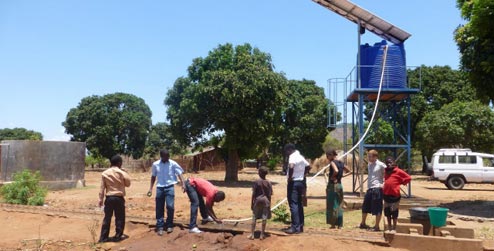Only an hour and a half away from the bustling Malawian capital Lilongwe, is the regional district of Salima. If you search through its streets full of traders, craftsmen and haphazard bicycle taxis you’ll find the Salima branch of Environment Africa...our home for the next seven and a half weeks! Our team of ICS volunteers consists of five UK members (Elle, John, Holly, Mike, Mungo) and three local members (Brian, Sam, Mphatso).
During our first week at EA we’ve been introduced to the structure, workings and current projects of EA Salima. Environment Africa was founded in 2001, and is rooted in a long running campaign to raise awareness for endangered African species. Zimbabwe based, it has since expanded throughout southern Africa to include Malawi, Mozambique and Zambia. EA now focuses on key areas such as sustainable livelihoods, climate change and biodiversity. Its Salima office has three current ongoing regional projects relating to these key areas, all of which have a heavy focus on achieving progress through community consultation, community involvement and consequently community empowerment.
This route to community empowerment gives people a sense of ownership over a project. Without this sense of ownership many projects are doomed to fail once the NGO departs. This’ll be the focus of the first blog, as one of our experiences so far has been exceedingly relevant to this! We’ve visited two solar irrigation projects, constructed by another NGO in 2009. They were inherited in 2012 by EA in an attempt to salvage something from the projects.

In both sites the same system is used, but at the first site it hasn’t been implemented well. I’ll avoid trying to explain its shortcomings and just say that the system is flawed. In effect the water is being pumped directly from the borehole, and out through a pipe which is used by the villagers for everyday domestic tasks. This circumnavigates the entire irrigation system, comprised of a huge storage tank and brick lined irrigation channels across 5 acres, making it redundant! There is still water being pumped constantly during daylight hours, but strangely none of it is being used for agriculture.
Which brings me to my point: the villagers seem completely disconnected from the project. This lack of interest is unsurprising given the way the NGO who formally managed the project approached the village. The villagers weren’t consulted, they didn’t contribute to the construction and most importantly they weren’t asked what they wanted. They felt marginalised, had no input and weren’t given ownership. The fact that none of the water available is being used for agriculture is proof of this.
There are other problems EA have faced whilst trying to engage with the community, many of which are to do with the history of how things there have been handled. I’ve barely scratched the surface in discussing them but for the sake of time we’ll move onto the second site.
The second site has been more successful; but the amount of land watered by the solar system is not as large as expected. However here the villagers are more engaged, and have responded to EA consultations. They’ve told EA that not enough water is being produced by the solar pump alone, and with guidance they have taken it upon themselves to construct shallow wells from which watering cans can be filled. The villagers also voiced concern over the sustainability of the solar system, which contains expensive components which they do not have the funds to replace (remember they weren’t consulted when this system was implemented). The villages have therefore requested a treadle pump which can be used to pump water manually from the shallow wells, a more sustainable method. EA have agreed to supply three of these, as well as deepen and line the shallow wells already constructed by the villagers.
This first entry has all been rather doom and gloom, but we’ve learned some valuable lessons from our time visiting these sites. Development works best when you work in partnership with the local community; when you listen to the wants and needs of the community; and when you involve the community to give them ownership over a project. I’d like to thank EA for showing us these sites, and hope that efforts made to reconnect the community with these projects are a success.
As a team we look forward to working with EA with a community minded approach!
Mungo Nash Progressio ICS volunteer in Malawi
Photos: Michael Dorrington 1: Volunteers helping make nsima 2: Inspecting a failed irrigation site



